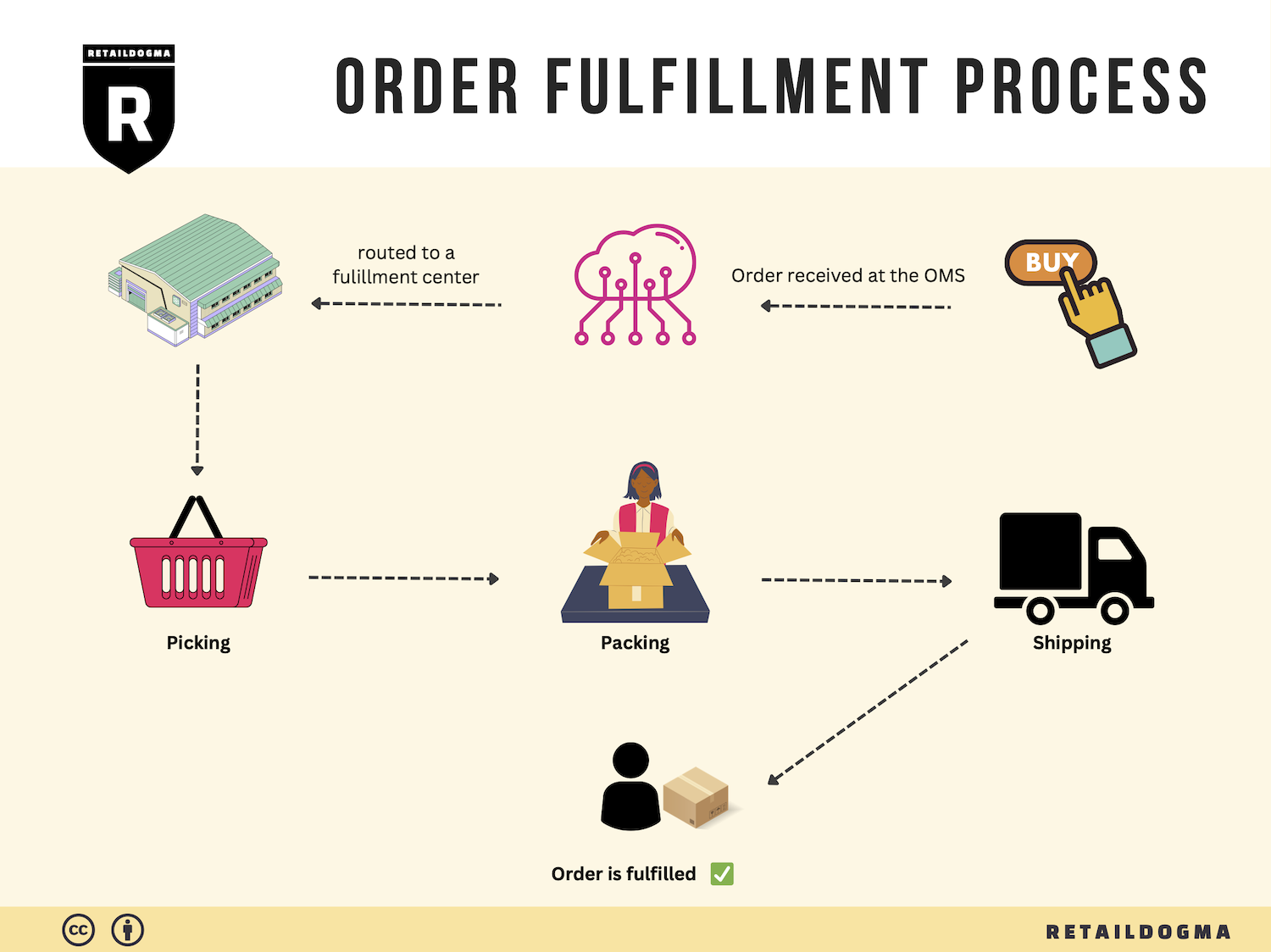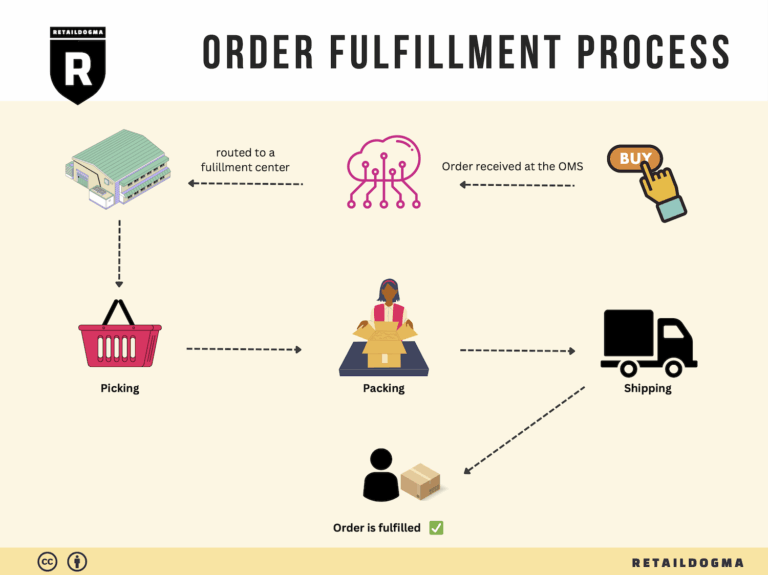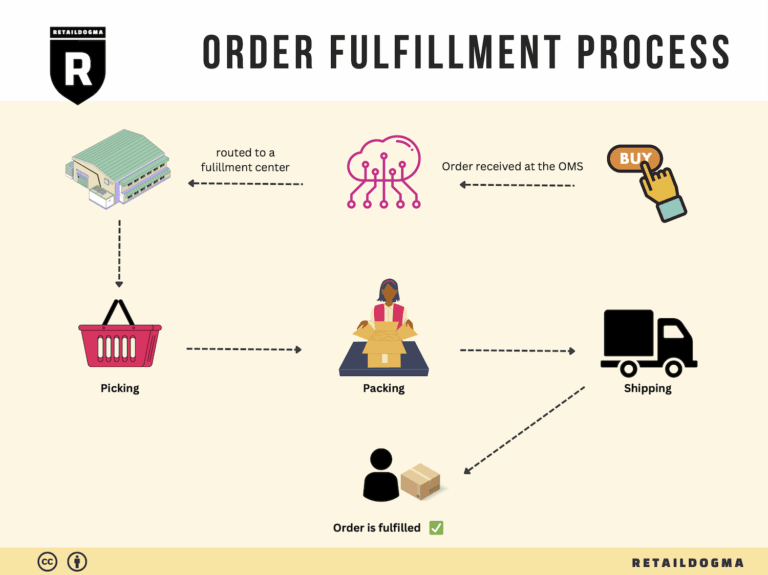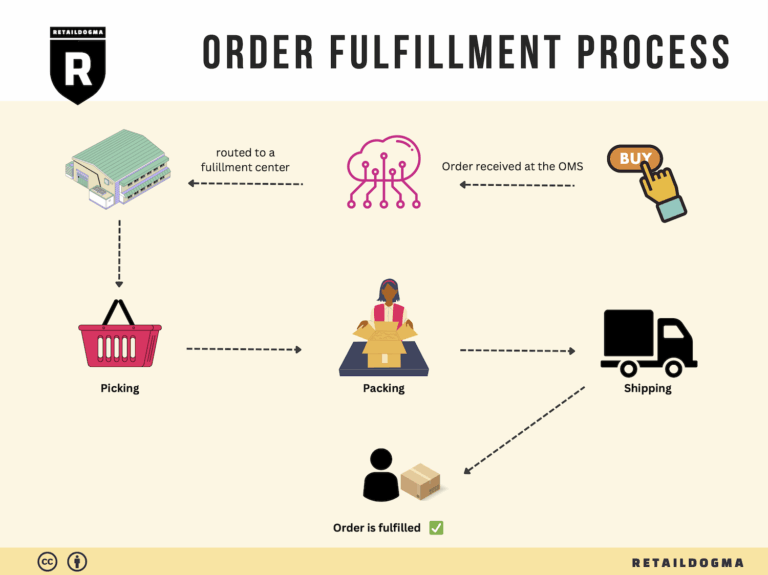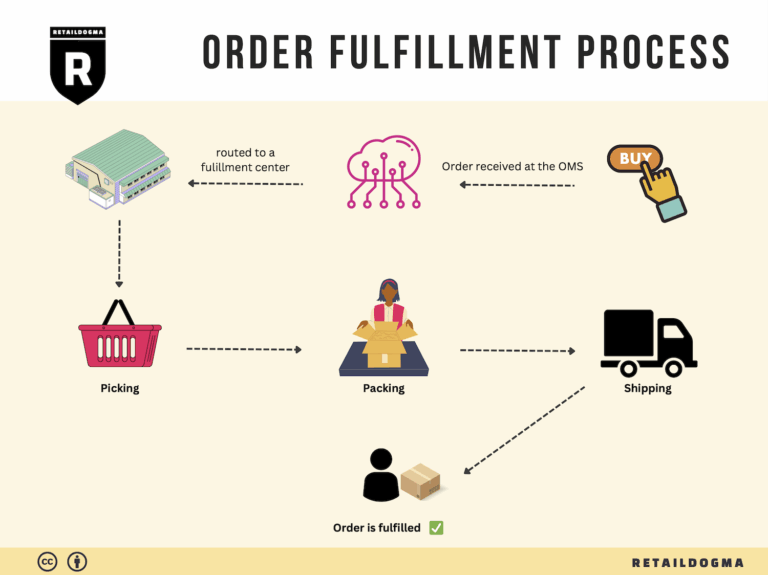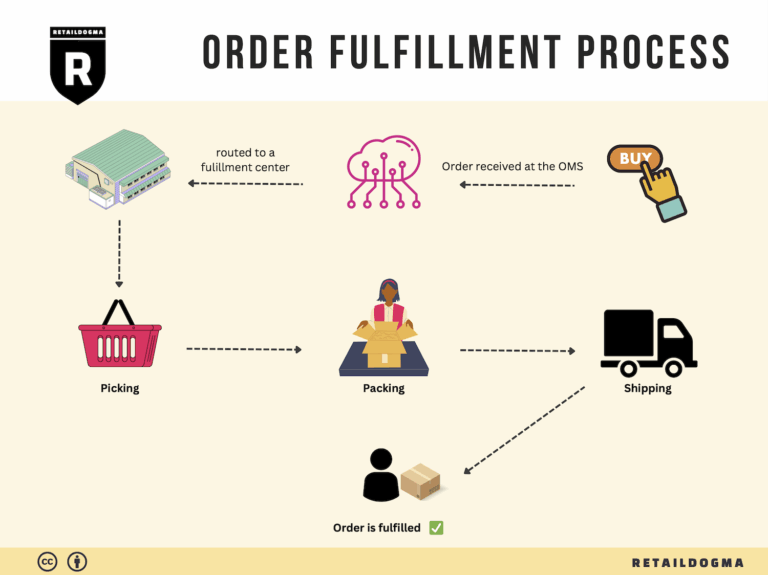Ecommerce Fulfillment Services: The Ultimate Guide (2025)
What is E-commerce Fulfillment? An Introduction for Growing Businesses
Understanding the Fulfillment Process
As an e-commerce business owner, you may find yourself grappling with the overwhelming task of packing and shipping orders, especially as your business begins to grow. The excitement of increased sales can quickly turn into stress when faced with the logistical challenges of getting products to your customers efficiently. This is where e-commerce fulfillment comes into play.
Simply put, fulfillment is the process of getting a product from your inventory to your customer’s doorstep. It encompasses everything from receiving an order to processing it, packing the items, and ultimately shipping them out. As you scale your business, understanding the nuances of fulfillment becomes crucial—not only for maintaining customer satisfaction but also for optimizing your operational efficiency.
What This Guide Covers
In this comprehensive guide, we will delve into the various models of e-commerce fulfillment that can suit your growing business needs. We’ll explore options like Third-Party Logistics (3PL) and Fulfillment by Amazon (FBA), helping you understand how these services can alleviate the burden of order management.
Additionally, we’ll break down the core services involved in the fulfillment process, including inventory management, packing, shipping, and returns handling. Each of these components plays a significant role in ensuring that your customers receive their orders on time and in excellent condition.
Choosing the right fulfillment partner is a critical decision for any business looking to scale. We’ll provide practical insights on what to look for in a fulfillment partner, including factors like reliability, technology integration, and customer support.
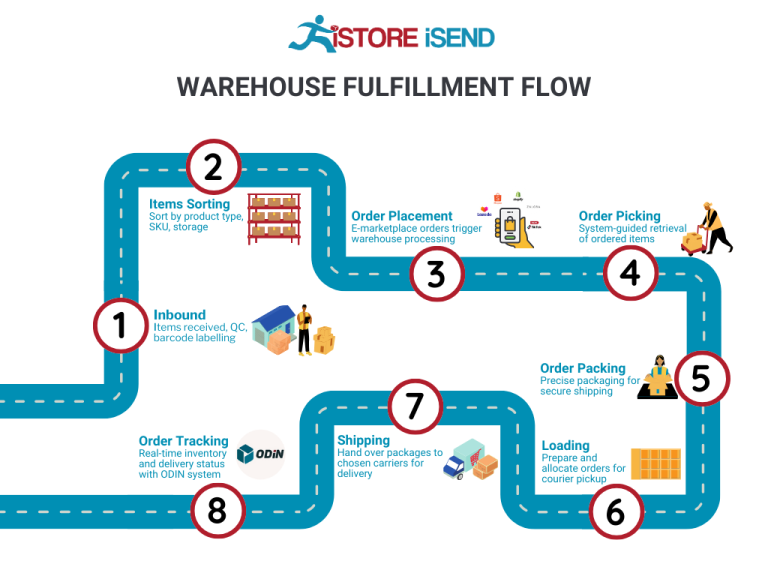
Lastly, we will discuss pricing structures associated with fulfillment services. Understanding these costs will empower you to make informed decisions that align with your budget and financial goals.
Empowering Smart Logistics Decisions
Our goal with this guide is to empower you to make smart decisions about your logistics. By demystifying the fulfillment process and offering actionable insights, we aim to equip you with the knowledge necessary to enhance your operational capabilities and improve customer experiences. As you navigate the complexities of e-commerce fulfillment, the right strategies and partnerships can significantly impact your business’s growth trajectory. Let’s explore how you can streamline your logistics and focus on what you do best: growing your business.
What You’ll Learn In This Guide
- What is E-commerce Fulfillment? An Introduction for Growing Businesses
- The Order Fulfillment Process: From ‘Buy’ Button to Customer’s Door
- Comparing Fulfillment Models: In-House vs. 3PL vs. Dropshipping
- A Deep Dive into Amazon FBA: Pros, Cons, and Who It’s For
- Core Services Offered by Fulfillment Centers
- How to Choose a Fulfillment Partner: A 6-Point Checklist
- Understanding Fulfillment Pricing: A Breakdown of Common Fees
- Frequently Asked Questions (FAQs) about Fulfillment
- Conclusion: Is Outsourcing Fulfillment the Right Move for Your Business?
- Important Disclaimer
The Order Fulfillment Process: From ‘Buy’ Button to Customer’s Door
1. Receiving Inventory
The order fulfillment process begins with receiving inventory, a crucial step that sets the stage for efficient operations. When products arrive at your fulfillment center, they must be checked against purchase orders to ensure accuracy. This involves verifying quantities, inspecting for damage, and confirming that the right products have been delivered.
Importance: Proper inventory receiving is vital for maintaining accurate stock levels and preventing discrepancies. A well-managed receiving process minimizes errors that can lead to stockouts or excess inventory, both of which can adversely affect customer satisfaction and cash flow.
Key Term: SKU (Stock Keeping Unit) – A unique identifier assigned to each product variant, making it easier to track and manage inventory.
2. Warehouse Storage
Once inventory is received, it is stored in the warehouse. Efficient warehouse storage involves organizing products in a logical manner, often by category, size, or demand frequency. Implementing a systematic storage strategy, such as ABC analysis, can help businesses prioritize high-demand items for quick access.
Importance: Effective warehouse storage maximizes space utilization and streamlines the picking process. When products are stored systematically, it reduces the time employees spend searching for items, leading to faster order fulfillment and improved overall efficiency.
Key Term: Bin Location – A designated spot within the warehouse where specific products are stored. Clearly labeling bin locations enhances retrieval speed and accuracy.
3. Order Picking
Order picking is the process of retrieving items from their storage locations based on customer orders. This step is critical as it directly impacts the speed and accuracy of order fulfillment. Depending on the volume of orders, businesses can employ various picking methods, such as single-order picking, batch picking, or zone picking.
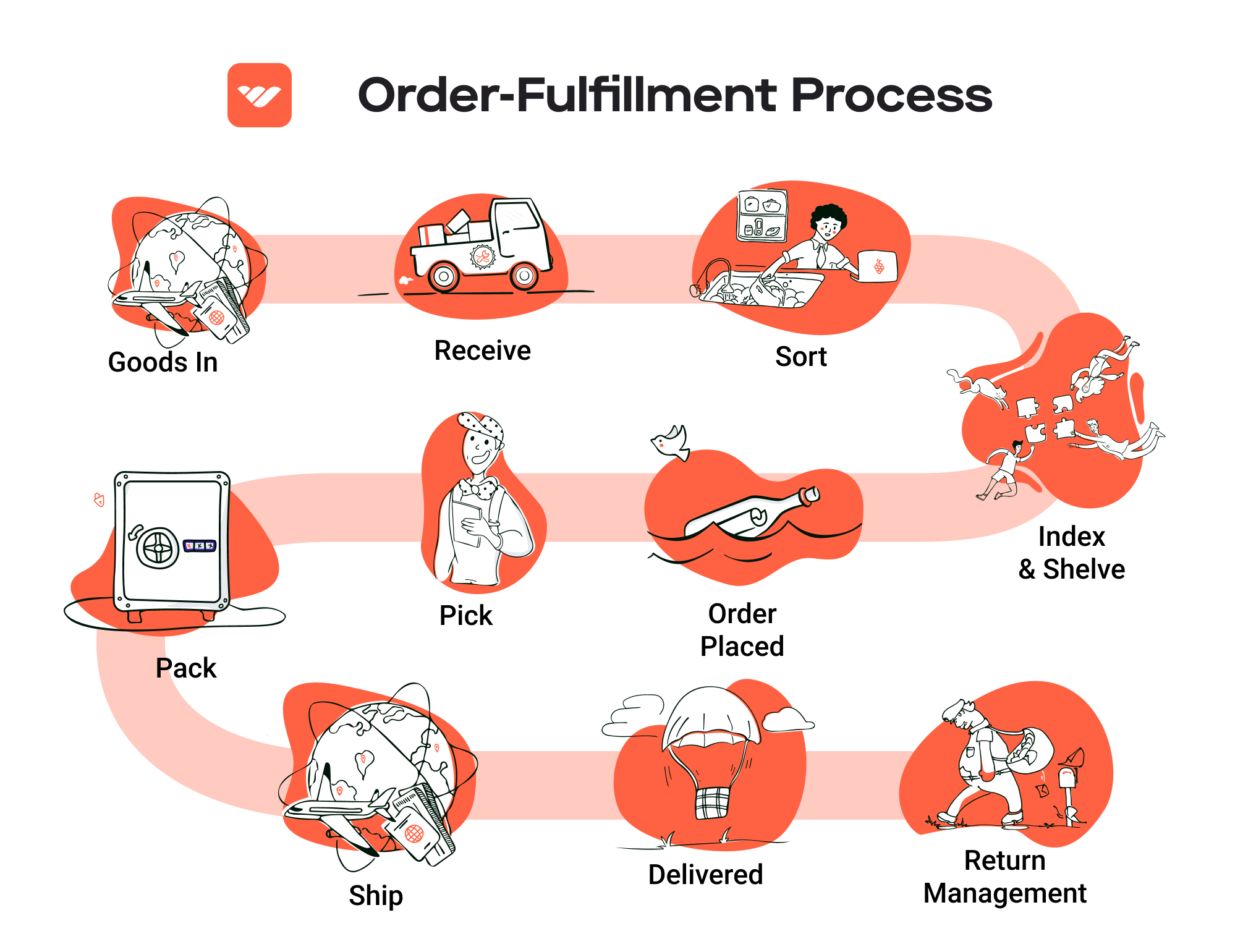
Importance: The efficiency of the picking process affects overall operational performance. An optimized picking strategy reduces labor costs and minimizes the time taken to fulfill orders. Additionally, accurate picking is essential for ensuring customer satisfaction, as incorrect items lead to returns and dissatisfaction.
Key Term: Pick List – A document or digital tool that outlines the items and quantities required for each order. It serves as a guide for warehouse staff during the picking process.
4. Order Packing
After items are picked, they move on to the packing stage. This involves securely packaging the products to prevent damage during transit. Proper packing includes selecting appropriate packaging materials, adding protective elements (like bubble wrap), and labeling packages accurately with shipping information.
Importance: Effective order packing is crucial for minimizing damage during shipping and ensuring that the right products reach the customer. Well-packed orders not only enhance customer satisfaction but also reduce return rates and associated costs.
Key Term: Packing Slip – A document included in the package that lists the items enclosed, serving as a reference for both the customer and the fulfillment center.
5. Shipping & Delivery
The final step in the order fulfillment process is shipping and delivery. Once packages are packed, they are handed over to shipping carriers for delivery to the customer. This stage involves selecting the most efficient shipping method, whether standard, expedited, or international, based on customer preferences and cost considerations.
Importance: Timely shipping and delivery are critical for maintaining customer satisfaction and loyalty. Delays or issues at this stage can lead to negative experiences and harm the business’s reputation. Effective communication regarding tracking information is also essential to keep customers informed about their order status.
Key Term: Tracking Number – A unique identifier assigned to a shipment that allows customers and businesses to monitor the package’s journey from the fulfillment center to the delivery address.
By understanding and optimizing each step of the order fulfillment process, e-commerce businesses can enhance operational efficiency, improve customer satisfaction, and ultimately scale their operations successfully.
Comparing Fulfillment Models: In-House vs. 3PL vs. Dropshipping
Fulfillment Model Comparison
| Model | Who Handles Inventory | Best For (Business Stage) | Key Advantage | Key Disadvantage |
|---|---|---|---|---|
| In-House Fulfillment | The business itself | Established businesses | Full control over inventory and processes | High overhead costs and labor management |
| Third-Party Logistics (3PL) | A third-party logistics provider | Growing to mid-sized businesses | Scalability and expertise in logistics | Less control over inventory and processes |
| Dropshipping | Suppliers or manufacturers | Startups and small businesses | Low startup costs and no inventory risk | Lower profit margins and reliance on suppliers |
In-House Fulfillment
In-house fulfillment refers to the process where a business manages its inventory, order processing, and shipping operations internally. This model is most suitable for established businesses that have a steady order volume and the resources to manage their own logistics. The key advantage of in-house fulfillment is that it provides complete control over inventory and the fulfillment process. Businesses can customize their operations to meet specific customer needs, ensuring quality and speed of service. However, this model also comes with significant disadvantages, including high overhead costs for staffing, warehousing, and technology. Additionally, businesses must invest in logistics management, which can be resource-intensive and complex, particularly during peak seasons when demand may fluctuate.
Third-Party Logistics (3PL)
Third-party logistics (3PL) involves outsourcing fulfillment operations to a specialized logistics provider. This model is ideal for growing to mid-sized businesses that are scaling their operations but may not have the resources or expertise to manage logistics efficiently. The primary advantage of 3PL is scalability; businesses can adjust their logistics capacity based on demand without significant upfront investments. Moreover, 3PL providers often have established logistics networks and expertise, which can result in faster shipping times and reduced costs. However, the key disadvantage is that businesses lose some control over inventory and the fulfillment process. This lack of oversight can lead to issues with stock management and customer service if the 3PL provider does not meet expectations.
Dropshipping
Dropshipping is a fulfillment model where the retailer does not keep goods in stock but instead transfers customer orders directly to a supplier or manufacturer, who then ships the products directly to the customer. This model is particularly attractive for startups and small businesses due to its low startup costs and minimal financial risk, as there is no need to invest in inventory upfront. Retailers can offer a wide variety of products without the associated costs of managing inventory. However, dropshipping comes with notable disadvantages, including lower profit margins and a reliance on suppliers for inventory management and shipping. Any delays or issues on the supplier’s end can directly impact customer satisfaction, making it crucial for businesses to vet their suppliers carefully.
Summary
Choosing the right fulfillment model is a critical decision for e-commerce businesses aiming to scale effectively. Each model—In-House Fulfillment, Third-Party Logistics, and Dropshipping—offers unique advantages and challenges. In-house fulfillment provides control but at a higher operational cost, making it suitable for established businesses. Conversely, 3PL services offer scalability and expertise, which can benefit growing businesses but at the cost of some control. Dropshipping, while minimizing upfront investment and inventory risk, presents challenges in profit margins and supplier dependency. Ultimately, the best choice depends on the business’s specific needs, resources, and growth trajectory. Consideration of these factors will enable e-commerce owners to make informed decisions that align with their operational goals and customer service standards.
A Deep Dive into Amazon FBA: Pros, Cons, and Who It’s For
Understanding Fulfillment by Amazon (FBA)
Fulfillment by Amazon (FBA) is a service provided by Amazon that allows sellers to store their products in Amazon’s fulfillment centers. Amazon then takes care of storage, packaging, and shipping of these products directly to customers. This service is designed to simplify the logistics of selling online, allowing businesses to focus more on their core operations while leveraging Amazon’s extensive network.
How FBA Works
- Product Listing: Sellers create product listings on Amazon and choose to enroll their products in the FBA program.
- Inventory Shipment: Sellers send their products to Amazon’s fulfillment centers. Amazon provides guidelines on how to prepare and package the products for shipment.
- Storage: Once the inventory is received, it is stored in Amazon’s warehouses until an order is placed.
- Order Processing: When a customer places an order, Amazon picks, packs, and ships the product on behalf of the seller.
- Customer Service: Amazon also handles customer inquiries and returns, providing a seamless experience for buyers.
- Payment: After the product is sold, Amazon deducts fees and remits the remaining balance to the seller.
This model allows sellers to leverage Amazon’s logistics capabilities, ensuring fast and reliable delivery, which is crucial in today’s competitive e-commerce landscape.
Pros of Using Amazon FBA
-
Prime Eligibility: Products fulfilled by Amazon are eligible for Amazon Prime, which attracts more customers who are looking for fast shipping options. This can significantly increase sales as Prime members tend to buy more frequently.
-
Customer Trust: Selling through FBA means that customers benefit from Amazon’s trusted brand reputation, which can enhance buyer confidence and lead to higher conversion rates. The assurance of Amazon’s customer service and return policies can also mitigate buyer hesitation.
-
Multi-Channel Fulfillment: FBA allows sellers to fulfill orders not just from Amazon, but also from other sales channels, including their own websites or other marketplaces. This flexibility can streamline logistics and inventory management across different platforms.
-
Scalability: FBA allows businesses to scale their operations without the need to invest heavily in logistics infrastructure. Sellers can focus on sourcing and marketing products while Amazon handles the fulfillment.
-
Time-Saving: With Amazon managing storage, shipping, and customer service, sellers can free up time to focus on growing their business, product development, or marketing strategies.
Cons of Using Amazon FBA
-
High Fees: FBA services come with various fees, including storage fees for holding inventory and fulfillment fees for each order processed. These costs can add up, especially for sellers with low-margin products.
-
Strict Inventory Rules: Amazon has specific guidelines regarding inventory management, including limits on the amount of inventory that can be stored. Sellers must also adhere to strict packaging and labeling requirements, which can be cumbersome.
-
Commingling Risks: FBA often involves commingling inventory, meaning that products from different sellers may be stored together. This can lead to issues if there are quality control problems, as a seller may receive negative feedback for issues that are not their fault.
-
Loss of Control: By using FBA, sellers relinquish some control over the fulfillment process. This can be a concern for businesses that prioritize personalized customer service or have unique fulfillment needs.
-
Complex Returns Process: Although Amazon handles returns, sellers may face challenges in managing returned items, especially if they need to assess the condition of returned goods or resell them.
Who is FBA Best For?
FBA is particularly well-suited for:
-
Small to Medium-Sized Businesses: Companies looking to scale without investing heavily in logistics can benefit from the efficiency of FBA. It allows them to reach a broader audience without the overhead costs associated with managing their own fulfillment centers.
-
E-commerce Entrepreneurs: New sellers who are just starting and may not have the expertise or resources to manage their own fulfillment can find FBA an attractive option to streamline their operations.
-
High-Volume Sellers: Businesses that experience high sales volume, especially during peak seasons, can leverage FBA to ensure they meet customer expectations for fast shipping and service without the complexity of managing logistics themselves.
-
Multi-Channel Sellers: Businesses that sell across multiple platforms can benefit from the multi-channel fulfillment capabilities of FBA, allowing them to centralize their inventory and streamline order processing.
In conclusion, Fulfillment by Amazon offers a range of advantages that can significantly enhance the efficiency and reach of e-commerce businesses. However, it’s crucial for sellers to carefully weigh the pros and cons, considering their unique business models, product types, and operational needs. By understanding how FBA fits into their overall strategy, e-commerce entrepreneurs can make informed decisions that support their growth ambitions.
Core Services Offered by Fulfillment Centers
Inventory Management & Warehousing
Inventory management is the backbone of any successful e-commerce operation. Fulfillment centers offer comprehensive inventory management services that include tracking stock levels, managing reorders, and ensuring optimal inventory turnover. They utilize advanced Warehouse Management Systems (WMS) that provide real-time data on inventory status, which helps in making informed decisions regarding stock replenishment and storage.
Benefits:
1. Optimized Stock Levels: By maintaining optimal stock levels, fulfillment centers reduce the risk of stockouts or overstock situations. This balance is critical for maintaining customer satisfaction and minimizing holding costs.
-
Data-Driven Decisions: With real-time visibility into inventory data, businesses can analyze sales trends and seasonal demand, allowing them to make proactive decisions about inventory purchases and promotions.
-
Cost Efficiency: By outsourcing inventory management to fulfillment centers, e-commerce businesses can lower their overhead costs associated with maintaining their own warehousing facilities, leading to improved profitability.
Pick and Pack Services
Pick and pack services are essential for the order fulfillment process. This service involves selecting items from the warehouse shelves (picking) and packaging them appropriately for shipment (packing). Fulfillment centers employ efficient picking strategies—like batch picking or zone picking—to streamline the process and reduce order processing times.
Benefits:
1. Speed and Accuracy: Fulfillment centers leverage technology, such as barcode scanning and automated systems, to enhance the speed and accuracy of order fulfillment. This means customers receive the correct items in a timely manner, leading to higher satisfaction rates.
-
Scalability: During peak shopping seasons or promotional events, fulfillment centers can easily scale their operations to meet increased order volumes without compromising on service quality.
-
Focus on Core Business: By outsourcing pick and pack services, e-commerce businesses can concentrate on core activities such as marketing and product development instead of the logistical complexities of order fulfillment.
Kitting and Assembly
Kitting and assembly services involve the grouping of individual items into a single package or kit, which may require additional assembly before shipping. This service is particularly valuable for businesses that sell complex products or bundles, such as electronics or promotional kits that require specific combinations of items.
Benefits:
1. Enhanced Product Offerings: Kitting allows businesses to create unique product offerings, such as gift sets or multi-product bundles, which can drive sales and increase average order value.
-
Time Savings: By outsourcing kitting and assembly, businesses save time and labor costs, allowing them to focus on other critical areas such as customer service and product innovation.
-
Improved Customer Experience: Well-assembled kits not only look professional but also enhance the unboxing experience for customers, leading to positive reviews and repeat business.
Returns Management (Reverse Logistics)
Returns management, or reverse logistics, is a critical service offered by fulfillment centers that handles the return of products from customers. Effective returns management includes processing returns, inspecting returned items, restocking inventory, and managing exchanges or refunds.
Benefits:
1. Customer Satisfaction: A streamlined returns process enhances customer satisfaction. When customers know that they can easily return items, they are more likely to make a purchase, reducing cart abandonment rates.
-
Cost Management: Fulfillment centers can efficiently manage the costs associated with returns, such as restocking fees and shipping. By reducing the return rate through effective quality control and customer education, businesses can improve their bottom line.
-
Data Insights: Returns management also provides valuable insights into customer behavior and product performance. By analyzing return reasons, businesses can identify trends that inform product development and inventory decisions.
In conclusion, partnering with a fulfillment center provides e-commerce businesses with a suite of services that not only streamline operations but also enhance customer satisfaction. By leveraging these core services—inventory management, pick and pack, kitting, and returns management—businesses can focus on scaling their operations while improving their overall efficiency and profitability.
How to Choose a Fulfillment Partner: A 6-Point Checklist
Location & Warehouse Network
Importance:
The geographical location of your fulfillment partner’s warehouses can significantly impact shipping times and costs. A partner with strategically placed warehouses can help you reach your customers faster and reduce shipping expenses.
Questions to Ask:
– Where are your warehouses located?
– How many warehouses do you operate, and what regions do they serve?
– Can you accommodate both domestic and international shipping?
– What is your process for managing inventory across multiple locations?
Technology & Integrations
Importance:
In today’s digital landscape, a robust technology stack is essential for seamless operations. Your fulfillment partner should offer advanced inventory management systems, order tracking, and integration capabilities with your existing e-commerce platforms.
Questions to Ask:
– What technology do you use for inventory management and order processing?
– Can your system integrate with my e-commerce platform (e.g., Shopify, WooCommerce, Magento)?
– Do you provide real-time tracking for orders?
– How do you handle data security and compliance with regulations?
Specializations (e.g., Cold Storage, Oversized Items)
Importance:
Different businesses have unique product requirements. If you sell specialized items—like perishable goods that require cold storage or oversized products that need specific handling—it’s vital to choose a fulfillment partner with the necessary capabilities.
Questions to Ask:
– Do you have specialized facilities for handling specific product types (e.g., temperature-controlled storage, oversized items)?
– What experience do you have with my specific product category?
– How do you ensure compliance with regulations related to my product type?
– Can you provide case studies or references from similar businesses?
Scalability & Capacity
Importance:
As your business grows, your fulfillment needs may change. A good partner should have the ability to scale operations quickly to accommodate increased order volumes, especially during peak seasons.
Questions to Ask:
– How do you handle fluctuations in order volume, particularly during peak seasons?
– What is your maximum storage capacity, and how quickly can you scale up?
– Are there any limits on the number of SKUs you can manage for me?
– How do you ensure operational efficiency during high-demand periods?
Pricing and Contracts
Importance:
Understanding the pricing structure and contract terms is crucial for maintaining profitability. Hidden fees and unfavorable contract conditions can quickly erode your margins.
Questions to Ask:
– What is your pricing model (e.g., per order, per item, monthly fees)?
– Are there any additional fees I should be aware of (e.g., storage fees, handling fees, shipping fees)?
– What are the terms of your contract, and is there flexibility for renegotiation?
– How do you handle billing and invoicing? Can I expect transparency in all charges?
Customer Support & Reviews
Importance:
The level of customer support provided by your fulfillment partner can directly impact your business operations. Reliable support ensures that issues are resolved quickly, minimizing disruptions.
Questions to Ask:
– What customer support channels do you offer (e.g., phone, email, chat)?
– What are your typical response times for support inquiries?
– Can you provide references or reviews from other clients?
– How do you handle disputes or issues related to order fulfillment?
Conclusion
Choosing the right fulfillment partner is a critical decision that can influence your e-commerce success. By using this checklist, you can evaluate potential partners based on their location, technology, specialization, scalability, pricing, and customer support. Taking the time to ask the right questions will help ensure that you find a partner that aligns with your business needs and supports your growth strategy effectively.
Understanding Fulfillment Pricing: A Breakdown of Common Fees
Initial Setup Fees
Initial setup fees are typically a one-time charge that covers the costs associated with integrating your e-commerce platform with the fulfillment service. This may include the configuration of software systems, inventory uploads, and the establishment of operational protocols. The fee can vary significantly based on the complexity of your business needs and the fulfillment provider’s requirements.
To calculate this fee, providers may consider factors such as the size of your inventory, the number of SKUs (Stock Keeping Units) you have, and the specific services you need (e.g., custom packaging, labeling). It’s essential to clarify what is included in the setup fee, as some providers might bundle additional services like training or ongoing support.
Receiving Fees
Receiving fees are charged when your inventory arrives at the fulfillment center. This fee covers the labor and resources required to unload, inspect, and stock your products. The calculation of receiving fees generally depends on the volume of goods received and the complexity of the receiving process.
Providers often charge a per-pallet or per-unit fee. For example, if you send a truckload of goods, the fee may be lower per unit compared to sending smaller shipments, as bulk handling can streamline the process. It’s crucial to understand how your products will be received, as variations in packaging or size can affect the overall receiving costs.
Storage Fees (per pallet/bin)
Storage fees are incurred for the space your inventory occupies within the fulfillment center. These fees can be calculated on a per-pallet or per-bin basis and are typically charged monthly. The rate may vary based on the season, with higher fees during peak times when demand for warehouse space increases.
When evaluating storage fees, consider factors such as the type of products you store (e.g., bulky items might take up more space), the expected turnover rate of your inventory, and any seasonal fluctuations in demand. Some providers may offer tiered pricing based on the amount of space you occupy, which can impact your overall costs.
Pick & Pack Fees (per item/order)
Pick and pack fees cover the labor involved in retrieving items from storage and preparing them for shipment. This fee is often calculated on a per-order or per-item basis, meaning that the more items you sell, the higher your costs may be.
The complexity of the order can also affect these fees. For instance, an order requiring multiple SKUs or special packaging may incur higher pick and pack fees compared to a single-item order. It’s advisable to inquire about any additional charges for special handling or customization, as these can significantly impact your fulfillment costs.
Shipping Fees
Shipping fees represent the costs associated with transporting your products from the fulfillment center to your customers. These fees can vary widely based on factors such as the shipping method (standard, expedited, international), package dimensions, weight, and destination.
Fulfillment providers often negotiate shipping rates with carriers, and these rates can be passed on to you. Some companies may offer flat-rate shipping options or discounts for high-volume shipments, which can help control costs. Understanding the shipping options available and how they impact your overall fulfillment pricing is critical for budgeting and customer satisfaction.
Tips for Getting an Accurate Quote
-
Provide Detailed Information: When requesting quotes, be as detailed as possible about your inventory, order volume, and specific needs. This includes the types of products, packaging requirements, and any special handling requests.
-
Compare Multiple Providers: Don’t settle for the first quote you receive. Compare multiple fulfillment centers to understand the range of pricing and services available.
-
Ask About Hidden Fees: Ensure that you inquire about any potential hidden fees that may not be included in the initial quote, such as surcharges for seasonal demand or additional costs for returns processing.
-
Evaluate Contract Terms: Understand the contract terms, including any long-term commitments and how fees may change over time, especially if your business scales.
-
Request a Trial Period: If possible, request a trial period to assess the fulfillment provider’s performance and ensure their pricing aligns with your needs before committing to a long-term contract.
By taking these steps, you can gain a clearer understanding of fulfillment pricing and make informed decisions that align with your e-commerce strategy.
Frequently Asked Questions (FAQs) about Fulfillment
1. What is pending remote fulfillment?
Pending remote fulfillment refers to the status of an order that has been received but is waiting to be processed at a fulfillment center that is geographically distant from the retailer’s main operations. This phase indicates that the order is in a queue for picking, packing, and shipping, but has not yet progressed to the shipment stage.
2. How long does pending remote fulfillment typically take?
The duration of pending remote fulfillment can vary significantly based on several factors, including inventory availability, order volume, and the distance to the fulfillment center. Generally, this process can take anywhere from a few days to over a week, especially during peak shopping seasons.
3. Why is my order stuck in pending remote fulfillment?
Orders can remain in pending remote fulfillment for several reasons, such as stock shortages, high order volumes during busy periods, delays with shipping carriers, or logistical challenges related to the remote fulfillment center.
4. Can I speed up the pending remote fulfillment process?
While there are limited options to expedite pending remote fulfillment, you can contact customer support for updates or check if the item is backordered. However, many delays are often due to logistical issues beyond your control.
5. What’s the difference between remote fulfillment and regular fulfillment?
Remote fulfillment involves processing orders at centers that are located far from the retailer’s main operations, often leading to longer processing times. In contrast, regular fulfillment occurs at a central warehouse, typically resulting in quicker processing and shipping times.
6. How does pending remote fulfillment affect shipping time?
Pending remote fulfillment can extend shipping times because the order is waiting to be processed at a distant center. If the processing takes longer than expected, it pushes back the overall shipping and delivery timeline, potentially leading to customer dissatisfaction.
7. What should I do if my order is pending remote fulfillment for too long?
If your order status remains pending remote fulfillment for an extended period (typically over a week), it’s advisable to reach out to the retailer’s customer support. They can provide specific information about your order and any potential delays.
8. Does remote fulfillment affect international orders?
Yes, pending remote fulfillment is particularly common for international orders due to the added complexities of cross-border shipping, customs clearance, and varying shipping times. This can result in longer processing times compared to domestic orders.
9. What is a fulfillment center, and how does it differ from a warehouse?
A fulfillment center is a specialized facility designed to handle the storage, picking, packing, and shipping of products directly to customers, focusing on order fulfillment. In contrast, a warehouse is primarily used for storage and inventory management, without the same level of focus on processing orders for immediate shipment.
10. What is a 3PL, and how does it relate to fulfillment services?
A 3PL, or third-party logistics provider, is a company that offers outsourced logistics services, including inventory management, warehousing, and order fulfillment. Many e-commerce businesses partner with 3PLs to efficiently manage their fulfillment processes, allowing them to scale operations while reducing overhead costs.
Conclusion: Is Outsourcing Fulfillment the Right Move for Your Business?
Evaluating the Benefits of Outsourcing Fulfillment
Outsourcing fulfillment can be a transformative decision for e-commerce businesses looking to scale efficiently. One of the most significant advantages is time savings. By delegating order processing, inventory management, and shipping logistics to a third-party fulfillment provider, you free up valuable time to focus on core business activities such as marketing, product development, and customer engagement.
Scalability is another key benefit. As your business grows, so does the complexity of managing increased order volumes. A capable fulfillment partner can seamlessly adjust to fluctuations in demand, ensuring that your operations remain smooth during peak periods without the need for extensive investments in infrastructure or staffing. This agility is particularly crucial in e-commerce, where consumer expectations for fast and reliable delivery continue to rise.
Moreover, partnering with a fulfillment service brings specialized expertise. Fulfillment providers are equipped with advanced technologies and industry know-how, allowing them to optimize inventory management and streamline shipping processes. This expertise can lead to improved accuracy, reduced shipping costs, and enhanced customer satisfaction, ultimately contributing to your bottom line.
However, it is vital to choose the right fulfillment partner. Your selected provider should align with your business goals, offer reliable service, and maintain transparent communication. Conduct thorough due diligence to ensure they can meet your specific needs and scale with you as your business evolves.
Call to Action
Now is the time to evaluate your current shipping processes. Conduct an audit to identify inefficiencies or bottlenecks that may hinder your growth. Consider whether partnering with a fulfillment service could be the strategic move that propels your business to the next level. Embrace the opportunity to streamline your operations and enhance customer satisfaction—your future success depends on it.
Important Disclaimer
⚠️ Important Disclaimer
The information in this guide is for educational purposes. Fulfillment services, pricing, and platform features change frequently. Always conduct your own due diligence and consult with providers directly before making business decisions.
